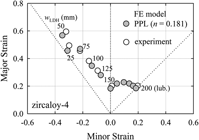Article contents
Numerical approach to the evaluation of forming limit curves for zircaloy-4 sheet
Published online by Cambridge University Press: 12 October 2015
Abstract

The forming limit strains (FLSs) of zircaloy-4 sheets are studied. After having obtained the true stress–strain curve of zircaloy-4 using the weighted-average method, limit dome height (LDH) tests are performed to establish experimental FLSs. We summarize related theoretical forming limit curves (FLC) and discuss their limitations. Two finite element (FE) models are established for determining FLSs; an LDH test FE model for the negative minor strain sector, and a biaxial tensile FE model for the positive minor strain sector. The numerical FLSs are found to agree well with experimental data. Since the numerical FLC gives the strain at the onset of local thinning (whereas the experimental FLC provides the strain between local necking and ductile fracture), resulting FE FLS values are slightly lower than the experimental ones so that results can be regarded as conservative. Our FE approach substitutes the expensive and time-demanding experimental LDH tests.
Keywords
Information
- Type
- Articles
- Information
- Copyright
- Copyright © Materials Research Society 2015
Footnotes
Contributing Editor: Yang-T. Cheng
References
REFERENCES
- 4
- Cited by

